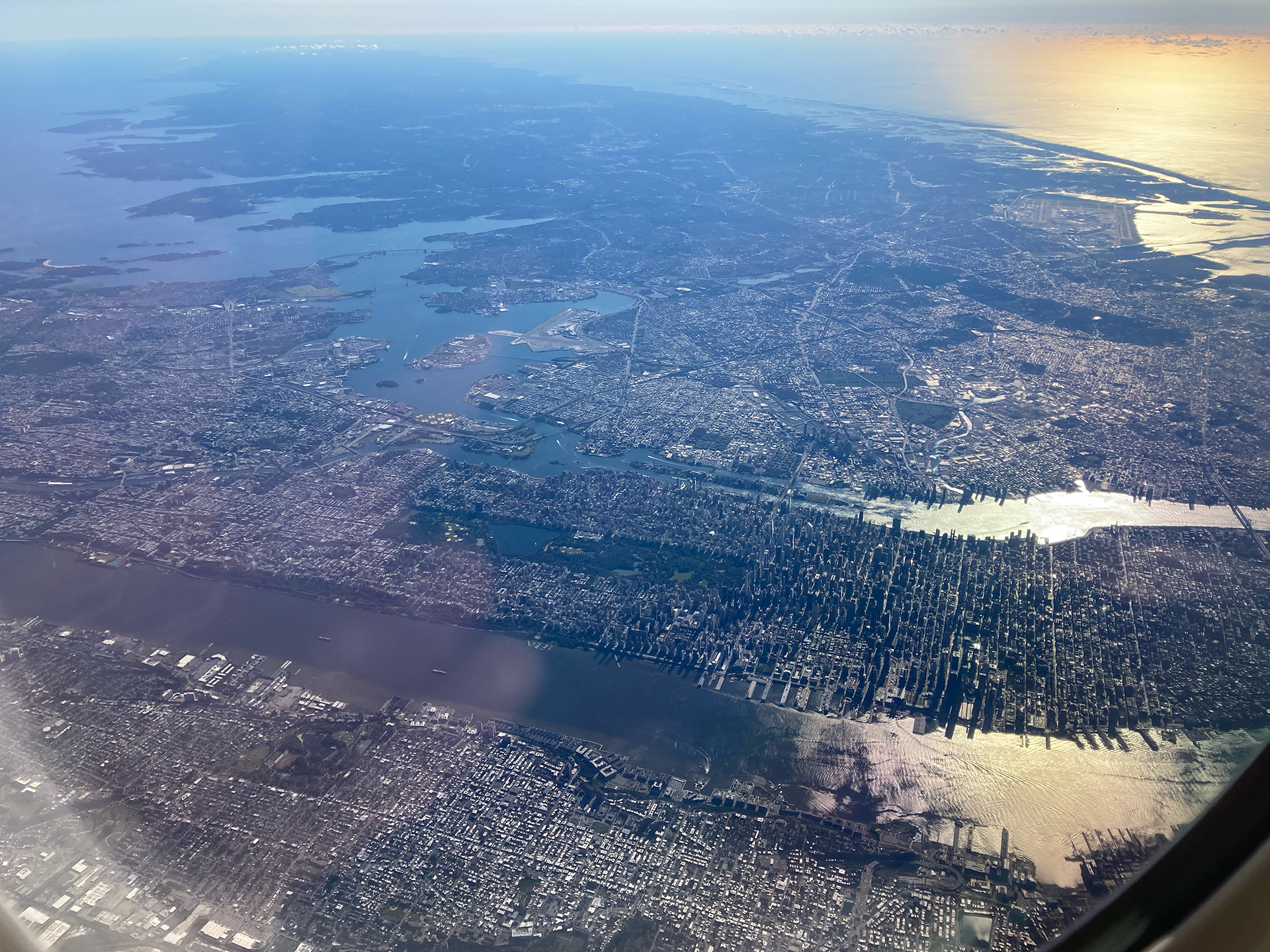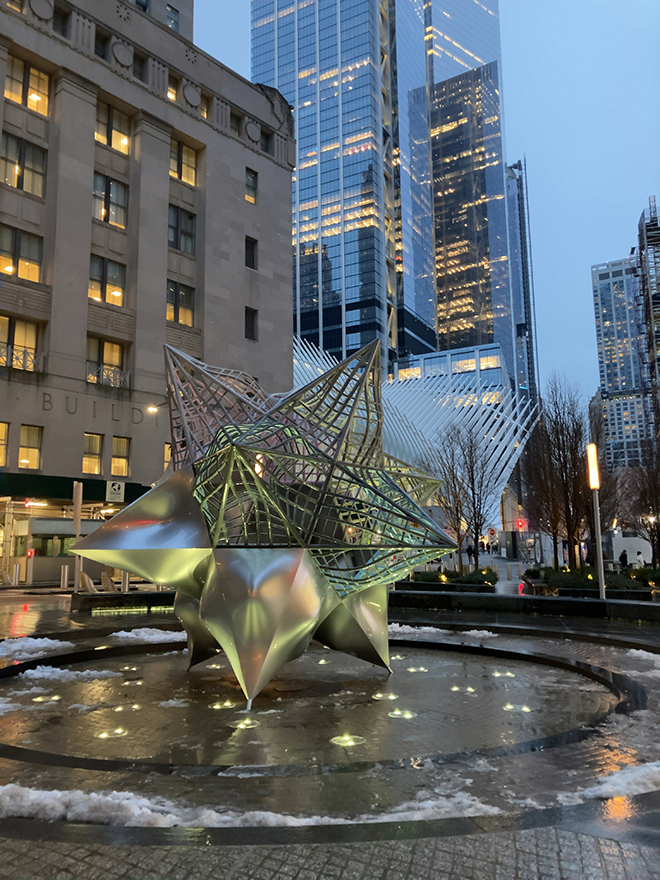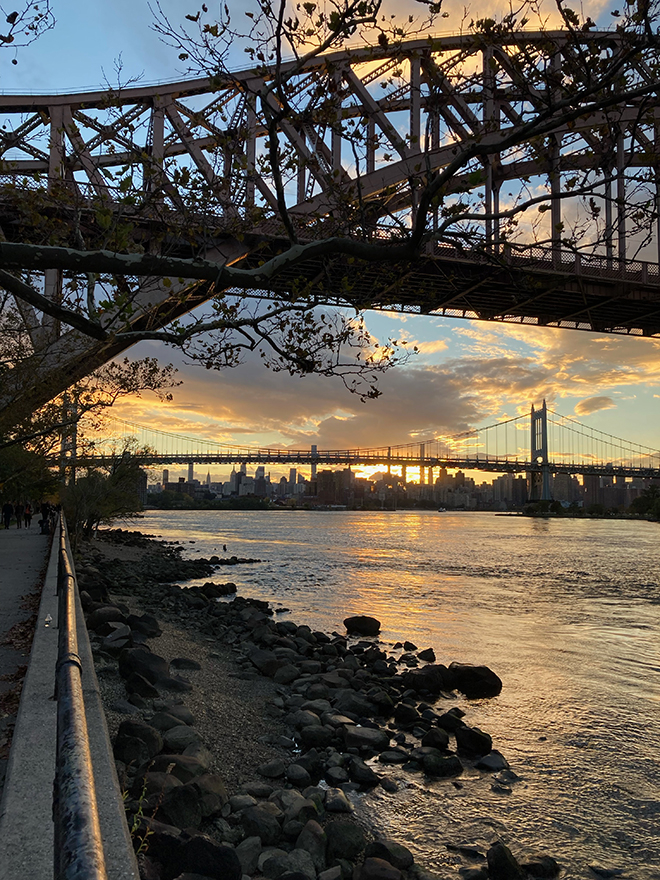This may be the Land of the Free, but there's plenty cause for righteous indignation
Technical notes for a stateside sojourn, plus a little extra (1)
By Kanai Manabu

Introduction
Close to three months have passed since I came to New York back in early October. The plan is to be here for a year. My stay in the United States is courtesy of the Program of Overseas Study for Upcoming Artists [*1] run by the Agency for Cultural Affairs , and I am taking part in a program run by Residency Unlimited(RU), an organization that offers artist-in-residence (AiR) opportunities in Brooklyn, through which I’m engaging in a range of activities encompassing both research and practical creative work.
I was asked by ICA Kyoto on this occasion to write about my experiences in the United States, and anything else that might be useful. Wondering what would be most beneficial to cover, I concluded that rather than using my allotted word count to describe my own activities in great detail, it would be better to deal with some slightly more real-life, technical matters. In part this is because although there is more general awareness these days of the actual existence of the Agency for Cultural Affairs Program of Overseas Study for Upcoming Artists, and of overseas artist residencies, it strikes me that very little is known specifically about such things as how people make these arrangements for themselves, what they do for funds, how and where they find hosts, and the process of actually undertaking research etc. on the ground. [*2] For those studying at undergrad or post-grad level right now and contemplating their next career move, information on the attractions of AiR programs and the meaning and possibilities of overseas residencies is certainly important, yet some discussion of the supporting structure of it all, if you like, is perhaps also needed. Obviously I am only able to describe my own experience (and the situation is always changing, or I could be mistaken, so people should still check things out for themselves), and for some it will feel like there is little new here, but hopefully what I write will serve useful in even some small way, as a kind of case study.

Frank Stella, 《Jasper’s Split Star》, 2017. Photo by Kanai Manabu
So my intention will be to cover mainly the technicalities of pursuing art studies overseas. But first I should explain who I actually am, and what I’m doing in America, so let me say a little by way of introduction. I work as an artist, but rather than simply making things (although ultimately I do make things), you could say I am developing my personal art practice by considering different aspects of “considerations in the processes by which humans make specific things.” To elaborate, I view art (works) as individual units generated as a kind of unique language or unique technical object, and center my activities on thinking about the logic behind that generation of things, and constructing a methodology for my own practice from that. For the past five or six years I have been pondering in my own fashion particularly the developments that occurred in American art from the late 1960s through the ’70s, that is the creative processes behind the unfolding of art practice generally positioned as the transition from Minimalism to Post-Minimalism (albeit within this, concentrating, in my case, especially on Frank Stella), and it is this interest that gave me the idea of pursuing my activities in the United States, preparing for a number of years before finally achieving my objective of being chosen for an AiR and the Agency for Cultural Affairs program, culminating in my arrival in New York in October.
Following that unintentionally long-winded introduction, I’d now like to discuss what I did to prepare for my present activities, how I go about research here in the States, producing work, and so on. I imagine the discussion will end up being split into a series of articles, but let me start by discussing preparations for the actual residency, and the circumstances leading up to it.
[*1] This is paid for by Japanese taxes, so allow me to extend a big thank you to all Japanese taxpayers.[*2] Though limited in nature, on his website the artist Tanaka Koki had posted what for me proved to be invaluable information on his practical preparations for a three-year stay in the United States on the Agency for Cultural Affairs Program of Overseas Study for Upcoming Artists. Artist Masuyama Shiro had also posted (and likely still is) information on his AiR experiences in various locations, and the grant funding received for those, that I seem to remember a lot of people using for reference. Hopefully what I write here will also prove similarly useful, even slightly, to someone, somewhere.
Where, what, and for how long
Though perhaps redundant, as those reading this will doubtless be already considering taking the opportunity of a residency or grant/scholarship funding for the express purpose of going somewhere outside Japan, so will already be clear in their intentions and reasons, allow me to offer a few thoughts on achieving the right balance between art activities, and duration of stay.
Prior to the Agency for Cultural Affairs program I had been lucky enough to study overseas for a year, and engage in several AiRs of two to three months’ duration each, and from these experiences, had formed the opinion that thinking about the “how long” is actually just as important as the “where and what (destination and objective).” The reason is that, once your stay goes beyond a year, the amount of time spent “outside” your main project due to that longer duration, that is, doing things like relocating to a different city, or just going about the business of everyday living, unavoidably starts to occupy more of your time, so it really feels to me that if you stress too much about “the smooth implementation of the project,” you could end up wasting too much of that “outside of” time (conversely, the exception being that when carrying out a specific project it will be more efficient to concentrate time and money). I began to believe that in the context of a long-term stay, while a person’s own specific interests may still be central, whether they feel they will be attracted to the whole package – the country, its society, urban environments, culture, people, all that lies on the periphery of their own interests in that place, and seems to throw those interests into relief – and whether they feel that the experience of these will have an impact on the thoughts in which their own art practice is grounded will likely have a huge influence on the essential value of a residency in the development of that person’s future art activities.
However, any attempt to work any inkling of this aspect into a proposal for a grant application or similar, will necessarily be abstract, and hard to explain within the permitted word count. Plus, there is no way of knowing whether, having explained in explicit terms the “concrete nature of an abstract idea,” somehow embedding that premonition about your stay in your application, those doing the judging will understand ( have the ability to understand). Making the whole idea a bit dubious. Still, in my view this is vital in terms of the essential development of art practice, and while some people may keep such thoughts to themselves and write the application “clearly and strategically,” personally that feels a bit like cheating to me, and most of all, is no good for those doing the screening, indulging them as it does, so is best avoided.
Money and visas
Once you have an idea what you want to do, where you ought to go, and how long you need, the next step is to put all the conditions in place for it to happen. In terms of practical problems, funds and visas are at the forefront of most minds, and the two are not unrelated. Step out of Japan, and you must obtain permission simply to be in a place, and confront a callous world where the question of money may also become part of this permission (it may be timely to recall that foreign nationals in Japan live constantly with this very same thing over their heads). Obviously if you have enough cash to fund your own stay, and the duration of your stay will be three months or less, and your destination is a country with a visa waiver scheme for those of your nationality, you can simply treat your foreign adventure like a slightly extended holiday, but any longer and you will require a lot of funds, and at the same time face the question of obtaining a visa. It is good if you have a link with an organization in your destination country that will allow you to obtain a visa that way, however for a temporary stay as an individual artist (not thinking of working in the country or migrating there), in most cases a visitor’s visa will be the one to aim for, which will require you to present proof of sufficient funds to conduct your activities in the country without employment. Most artists, struggling financially at the best of times, would find it difficult to come up with the cash to fund a stay of a few months to a year entirely independently (at least that was the case with me), so will look at accessing grant funding or programs to support their activities.
For an ordinary AiR of two to three months’ duration, or a medium-term stay, there are numerous options, including an invitation from the AiR program itself that also includes financial assistance, and multiple groups and organizations that offer grants for taking part in AiR programs, so let us set those aside for the moment. A trickier challenge is that of a long-term residency, the main, most generally available options (not requiring affiliation with a specific school or body, nor an invitation, but open to all applications) being 1) University study, 2) An institution for professional artist training, or 3) Support from the Agency for Cultural Affairs or a foundation. 1) will be an overseas government scholarship or similar, and is an option if you meet the criteria for application and your activities during the residency would benefit from affiliation with a university or research institute. As for 2), though the competition is exceedingly high, making them very hard to get into, if there is a facility like the Dutch Rijksakademie or German Akademie Schloss Solitude in the place you want to be, you meet the age and other criteria for applying, and the program there appeals (and you apply and are lucky enough to be accepted), I imagine this is a great option. Unfortunately I never have been accepted for one of these, so have no inside knowledge of them. Option 3) refers to programs such as that of the Agency for Cultural Affairs I am currently receiving support from, and the fellowships and grants offered by various foundations.
To elaborate a little on 3), there are government schemes (Agency for Cultural Affairs), and private-sector foundations and bodies (in Japan/in the planned destination country etc.): the former being the Agency for Cultural Affairs Program of Overseas Study for Upcoming Artists, and the latter, in Japan the likes of the Pola Art Foundation and Yoshino Gypsum Art Foundation; and in the US, the Asian Cultural Council (ACC) and Pollock-Krasner Foundation. The type of assistance given and the programs are all different, making it hard to generalize, but the Japanese programs do often have a predetermined host for the residency (study), and/or other criteria such as age, so it pays to check these conditions before applying.

Photo by Kanai Manabu
Agency for Cultural Affairs Program of Overseas Study for Upcoming Artists
Now for some more specific discussion of the Japanese Agency for Cultural Affairs Program of Overseas Study for Upcoming Artists. Leaving the matter of “hosts” at the destination for the moment, let me start with a general overview of the system.
The Program of Overseas Study for Upcoming Artists is a scheme offering financial assistance with travel and living expenses for a “study” period of one to three years overseas. First let us acknowledge that the very existence of such a scheme is ample cause for celebration, and deserves to be better known not only among artists and art professionals, but the wider community.
Applications for the program are open once a year. Currently the deadline for applying tends to be around summer. You submit the application documents, which are used to perform an initial screening, then you will receive a letter informing you of the results, with information on the second part of the process if applicable. This involves an interview around January–February, with the final result released in March. If your application is accepted, you must commence your studies between September of that year and March of the following, so if in employment, you’ll need to consider what to do about your job. This will also depend on the conditions at your place of employment, but in my case, I quit before heading overseas (and unfortunately don’t make enough to live on by selling my works), so on returning to Japan will be “age 39, unemployed.” Hardly a welcome state of affairs knocking forty, but a risk that has to be taken.
In terms of funds provided on the program, countries and cities around the world are categorized according to the cost of living there, among other factors, and the amount of support determined accordingly, which allows you to make plans in advance. The problem is that for the most part, the amount received is low relative to current global price indices, and also, in some regions, fails to properly reflect recent fluctuations in prices and exchange rates, but on the other hand, paid work is not permitted during the study period (in saying that, the reasoning is that you should be concentrating on your studies rather than working, which is fair enough). In brief, there is a possibility that you will run out of money, something that becomes more likely the more you actively try to do. In addition, though on a residency overseas, in reality you’ll have to store some of your belongings in Japan, plus if you’ve quit your job to go overseas, you may need cash to tide you over on your return until you find work. Or you may have to pay some of the living costs for children or other family members back in Japan (even more if they come with you). So you’ll still need money for things other than your studies. It would be better I believe if more people realized that as part of the practical preparations for applying, they may well need to draw up an advance plan that includes any costs likely to arise outside of their studies, and if necessary, start by saving (a percentage of people do already prepare like this). I personally wonder, considering the parlous financial state of most artists in Japan, how desirable it really is to have a government program, moreover one supporting “upcoming artists,” that in reality requires a certain degree of self-funding. But at any rate, this is the situation for the time being.
When applying for a visa for the United States, the visa you can obtain will also depend on your choice of host. If it is a large organization or research institute with US government accreditation you may be able to receive a J (exchange visitor) visa, or depending on your previous record as an artist, or if requiring a stay of several years, you may look at getting an O (individual with extraordinary ability or achievement) visa. But in my case, the planned duration of my stay is one year, and the host organization a small non-profit (so not a J visa sponsor), so I am here on the visa mentioned earlier, the purpose of which is the most simple kind of visit, ie a B (business/tourist) visa. The application was completed online and followed by an interview at the US embassy, and although due to pandemic delays it took a while (about three months), because of the difficulty of making an appointment for the interview, the process itself was very simple once I’d assembled the necessary paperwork (letters providing evidence of funding from the Agency for Cultural Affairs, and proof of my status as a student on the OSP, letter from the host organization, documents providing proof of my personal finances etc). Quite apart from a visa, in the case of the United States, whether you can enter the country and for how long is ultimately decided during immigration procedures on arrival at the airport. I had heard that on a B visa often people are granted a six-month stay and have to apply for an extension in the US to remain the whole year, but in my case maybe the immigration officer was feeling generous that day, because after I’d explained the circumstances of my stay, he gave me a one-year permit, just like that. I guess you have to get lucky sometimes.
Technical notes for a stateside sojourn, plus a little extra (2)Technical notes for a stateside sojourn, plus a little extra (3)
Technical notes for a stateside sojourn, plus a little extra (4) part 1
Technical notes for a stateside sojourn, plus a little extra (4) part 2
Kanai Manabu
Artist. Born in Tokyo in 1983. After his graduation from Jiyu Gakuen College, he received his Master’s degree from Institute of Advanced Media Arts and Sciences (IAMAS) and his PhD from Tokyo University of the Arts. He is Currently working in New York with the support of the Agency for cultural Affairs’ Program of Overseas Study for Upcoming Artists.